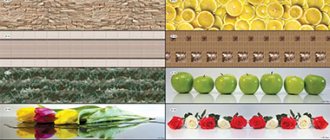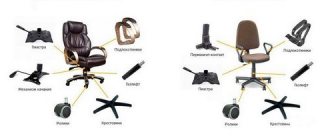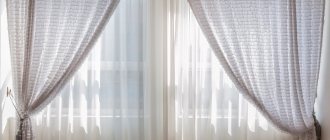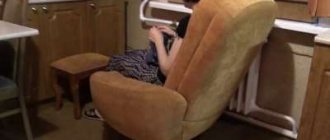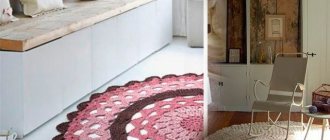Not everyone likes the hard seats of chairs and stools - it is uncomfortable to rest on them for a long time. Therefore, many try to make either pillows or special covers with soft filling; they do not move off the surface, but they can be removed at any time to use a piece of furniture as a stand for household work (screwing in light bulbs, whitewashing the ceiling, etc.).
New covers for stools will not only update the interior of the kitchen, but also make hard seats comfortable.
A hand-made stool cover significantly increases the comfort of use of a kitchen attribute. You can spend longer time over evening tea or family dinner. The kitchen space will benefit greatly if you complement the furniture with similar decor.
Stool covers are very easy to sew, and any housewife can complete the job in a couple of hours.
Pros of making it yourself
Hand-made items fully meet the style preferences of the apartment owners. Stools with removable “upholstery” are also practical and protect the surface of kitchen furniture from premature abrasion.
While working on the seat, you can evaluate how suitable the product is in size, which may not happen with a purchased version.
If you sew a cover for a stool with your own hands, it will cost a minimum of money or free of charge when all the materials are at home.
The made seats will look original in the kitchen interior.
The stools will require little fabric and filling, and the appearance of the furniture will change for the better.
The seats, improved by covering, are comfortable and durable. The “upholstery” can be easily removed and washed if necessary.
The seats can be removed to use the stool for household chores without dirtying the fabric.
How to crochet a cover for a stool
Knitting as a process seems simple and easy only from the outside. In fact, there are a lot of subtleties and nuances here. Therefore, when starting to knit a new product, you need to pay attention to the following points:
- Knitting technique. This is the determining factor. Ultimately, the appearance of the future cover depends on it.
- Yarn. It is not necessary to buy a separate skein for each option. In some cases, it is possible to make beautiful things knitted exclusively from leftovers.
To create one cape, it is not necessary to buy new skeins of thread.
Use remains in a variety of ways. Little tricks:
- If you fail to guess the size and the rug turns out to be smaller, you can increase the size using a border.
- It is better to make bedding from wool.
- To avoid “walking” in height, it is advisable to choose threads of the same type and, if possible, from the same manufacturer.
If your goal is to create a product “for the soul,” one that will attract the eye and complement the interior, then you need to first of all include the designer’s thinking.
Note! Knitting using a crochet hook takes significantly more time than the same amount of work done using knitting needles. Therefore, it is recommended to carefully select the scheme you like.
The harmony of the color scheme with surrounding objects and walls can be seen, as well as such nuances as ornaments and patterns that can become the highlight of any style.
Typical patterns of knitted rugs
To crochet a stool cover the way it appears in your imagination, you need to be able to read patterns well and strictly adhere to them. To begin with, you should choose models that are simpler, either based on practical considerations or specific operating conditions.
To preserve the finished product for as long as possible, it should be based on a dense base.
Square, under a stool
The square cover is one of the most popular, since most stools and chairs have this exact seat shape.
Typical knitting pattern:
A very interesting and simple option is the scheme for creating a square seat from colored stripes.
The process usually starts with measuring the seat. If you have no ideas for decoration, a cover with alternating colors and stripes would be a good solution. This will not affect the process itself, but it will look interesting. You can choose colors in a certain order or make a “chessboard”; the choice here is purely individual.
The required strip length is easy to calculate. It should be the same as the length of the seat. The width of the stripes themselves should be the same.
The most difficult thing with this pattern is tying the corner. Having reached the edge, you should add a little more knots: two elements starting in the same arch. As for the assembly, it is best to do it using a contrasting thread: the connecting column must be formed on symmetrical loops at the edges of the squares.
Thus, you will receive a fashionable piece of furniture in a hand-made style.
Important! To avoid the appearance of “waves”, you should choose a hook for the connection that is a size smaller than the main one.
Round, for seat with sides
Since it is much easier to crochet a round stool cover than a square one, denser threads are usually used for such products.
Example diagram:
The simplest option is a round knitted chair cover.
The main thing is to always start the circle from the center! In its simplest form, knitting is carried out according to the rule of addition.
In general, to create a foundation, the work order might look like this:
- Fit the air loops and roll them into a ring.
- Wrap around the ring. The first row comes with single crochet stitches.
- Use the resulting base in accordance with the chosen scheme.
For a crocheted stool cover, it is best to use thick acrylic yarn and a large hook.
The required diameter is determined by the number of rows completed. The edge (last) row can be passed through connecting posts with an elastic thread to form a collar.
Rug-flower
Recently, crocheting patterns for stool covers in the stylization of a flower have become popular: chamomile or sunflower.
Example diagram:
The thing will be voluminous, softer, and sitting on such a stool will be a pleasure.
To knit the same sunflower, you will need yarn of two colors: brown and yellow. In general, such work includes three main stages: creating the middle, knitting the petals and connecting the resulting parts. It is best to use cotton threads for such a cover.
Sequencing:
- Tie the base in any convenient way
- Start the petals with air loops, tying a single crochet on both sides.
- You can attach the petals with a simple thread.
DIY knitted cover for a stool in the shape of a bright sunflower.
Chair back cover
Typically, such covers are equipped with additional decorations and are knitted using patterns and several colors.
Example diagram:
To create a rectangular cape, you can use the same pattern as for a square one.
Since such a product is not a crocheted cover for a stool, it requires great skills and abilities. Therefore, as an algorithm of action, it is worth citing several general techniques:
- The base is a solid canvas. Can be made in both color and pattern. In order not to miscalculate the dimensions, you will need to measure the height and width of the backrest. You need to knit it in a single piece of double height, then fold it in half and sew it together.
- You can tie lace along the edge.
Rectangular covers for the backs of chairs, made by yourself.
Full chair cover, with backrest
Such covers use the principle of a continuous passage, so the type, type and style are selected individually. In principle, they always look good, and they are quite easy to knit:
- Measure the dimensions of the seat and backrest.
- Start with air loops - they are typed to the required width.
- As for the technique, you need to knit with simple double crochets: just like crocheting a cover for a stool, only in parts: along the length of the seat, back and bend. All elements are connected to each other by air loops.
- The sides and back are hemmed in the same way.
For decoration, simple ornaments are chosen, like this:
Choose the color at your discretion, based on the color scheme of the interior.
Materials
Requirements for materials stem from the place and nature of operation of the future product. If this is a decorative cape, it is preferable to use a simpler type of thread, while a chair cover will require stronger yarn. From here we can formulate general recommendations in relation to the preparation of materials:
- The choice of threads with different colors should take into account the length of the skein. Ideally it should be the same.
- It is advisable to select skeins of the same length (on average, 150 m per 100 g).
- For beginners, it is better to stick to cotton yarn (“Iris” or similar).
- It is allowed to take “prickly” threads.
If the pattern for knitting pillows on a stool involves the use of threads of different colors, their type and brand should still be the same.
Important! The hook should be selected based on the thickness of the yarn - the narrowest point should be twice as thin as the selected thread. Otherwise, the structure may turn out to be “loose” and sloppy. For most cases, the optimal diameter will be 3mm.
Crochet cover for a stool
Many people have a desire to knit, but only a few actually get into knitting. Most people are put off by the need to memorize dozens of types of loops, and especially to understand the complex patterns that are often given in magazines. In fact, there is nothing super complicated here. It's not that hard, just remember a few rules:
- Rectangular and square diagrams are “read” from bottom to top. Round - from the center.
- When knitting covers on a round stool, you need to put it on from the center. You should remember about the lifting loops so that the radius is the same. The number of added columns must be equal to the number of existing ones.
- For an even row, counting goes from left to right. For odd numbers it’s the other way around.
If you follow the description of the patterns, the time spent knitting will not be onerous work.
In addition, you can print out and put a sheet of symbols next to it - this will make it easier to read the diagrams.
Note! Covers and rugs, knitted according to simple patterns, are made using basic types of loops (connecting, columns, double crochets, double crochets).
Create a stunning flower that will soon bloom on your stool with intricate ethnic or abstract patterns.
Design and construction
Your products will be shaped like the seats. If these are stools intended for the kitchen, then it is better to sew not cushions, but capes with elastic that can be easily removed for washing.
Such covers for stools are very practical: they can be removed and washed, which is important for the kitchen.
If the seats are made with your own hands, then you can choose any textiles and filling. These are unnecessary scraps, foam rubber, tapestry with a large pattern and other materials.
The seats can be decorated in one color or use an ornament.
The latter looks quite stylish and interesting if the color scheme is matched to the interior.
What types of covers are there?
Sewing patterns for chair saddles are presented in a wide range. Users can choose products of any shape, size, style. Covers can be round or square, completely covering the legs of the furniture.
Homemade stool seat
Based on the type of fastening, the following types of capes are distinguished:
- with ribbons;
- with ties;
- with elastic band.
Chair covers are also attached using loops.
For your information! Diversity is also observed in the color scheme: covers can be either soft pastel or bright acidic. It all depends on the taste preferences of the user.
DIY chair cover
Required materials and tools
To make a soft base for the seat you will need:
- Fabric (dimensions are calculated as follows: surface area plus 10 cm);
- Textile elastic band of medium width (2-3 cm);
- Strong threads to match the background color of the fabric;
- Chalk or piece of soap for marking;
- Ruler;
- Pin;
- Sewing machine.
Choose fabric for the seat that is dense and wear-resistant. The tapestry is perfect.
It is best to make a lining from softer textiles, which will follow the shape of the top of the stool.
The ideal filler is dense foam rubber with a height of 3-4 cm, no more, otherwise the seat will deform and slide off the stool. For chairs, filler should be 6-7 cm thick. If foam rubber is not at hand, then thin or thick felt, woolen fabric, padding polyester and even unnecessary shreds will do.
The material must be laid in several layers - three or four will be enough.
It is recommended to make the filling from shreds unmixed; you should sew the pieces of fabric together, since after washing they can bunch up in the corners.
How to decorate: types of decor
Knitting is a process that is impossible without the work of imagination and imagination. Since crocheting patterns for a stool cover mostly involve simple shapes, why not decorate them:
- Lace and tassels. This element looks good around the edges. Especially on a square shape.
- Embroidery. Both classic beads or rhinestones and top processing with threads are used.
- Bows. They look good made from ribbons or fabric, and also knitted.
- Pompoms. Like tassels, they will perfectly decorate a cape, except that this is more suitable for children’s furniture.
To create it, you need to knit a sufficient number of individual colors and then connect them, guided by the diagram.
You can also use various patterns or unusual combinations of all kinds of circles, squares, lines and zigzags as decorations. For more experienced ones, it makes sense to “play around” with the form.
The final stage is decoration
For a DIY stool seat, appearance is important. If you use a tapestry with a pattern, then a large floral pattern with a flower in the center looks great. Due to the soft combinations of shades, it does not look pretentious, but rather stylish.
Several stools made in the same style give the kitchen an organic feel.
You can also decorate the seats using embroidery on your soft product. Like a tapestry with a central pattern, a large flower made using the satin stitch technique will look good. A perimeter ornament or an abstract image also looks great. For embroidery, use durable, color-resistant threads that will not wear out from frequent use and washing of the cape.
Design options for covers for chairs and stools.
Kitchen stools can be varnished or painted to match the seats. It is better to do this before sewing to allow the entire item to dry evenly. Considering that the furniture will be used frequently, it is recommended to apply two layers of paint or varnish for less wear.
Soft and beautiful handmade capes will immediately please your guests.
Preparing fabric and foam
Before sewing the cape, you will need to carefully smooth the fabric so that there are no wrinkles on it. You will also need to prepare foam rubber for softness. There are several types of fillers that are used for sewing furniture covers. The most popular of them are:
- padding polyester Artificial and durable foam rubber that does not lose its shape, has good elasticity, and shows high thermal insulation properties. Sintepon is inexpensive, which is why many users choose it for upholstering stools. The downside is that the material allows air to pass through and loses its properties at low temperatures;
Sintepon for capes
- holofiber. The material is made of springy fibers, it shows good ductility. Hollow fiber can be washed in a washing machine. The fiber is breathable, easy to clean, does not require special care, and holds its shape for a long time. Disadvantages - the material can absorb liquid, it does not tolerate increased humidity levels in the room;
- foam rubber Dense material that holds its shape well. Foam rubber is flexible, practical, hypoallergenic. It withstands temperature changes in the room and retains its shape at sub-zero temperatures. Disadvantages - the fiber is not environmentally safe, and foam rubber is also quite fire hazardous.
For your information! Before you start sewing, you also need to take measurements of the furniture in order to cut the fabric to the right size.
Filler for accessories
Seat care
The soft removable part of the stools must be washed periodically as it tends to get dirty regularly. This is especially true for kitchen stools.
Washing should be carried out in a gentle mode at a temperature of 40 degrees, so as not to deform the base.
It is recommended to dry the product flat out, in a place where there is no direct sunlight, otherwise the design will fade.
To sew covers for 4 Ikea stools for the kitchen I needed:
1. Fabric - teak pillowcase - 1 m.
2. Fabric - quilted padding polyester on a cotton base - 1m.
3. Elastic underwear 4 m.
I chose the fabric according to the color scheme of my kitchen, as well as wear resistance - the material should be dense, not loose, you understand that stools are an item that is used every day. Gabardine will do, like in this master class when I showed how to sew a cover for a computer chair. But the store didn’t have a suitable color, but the teak pillowcase was in a beautiful color and everything was decided.
Measurements and pattern
In order for the pattern to be accurate and the product to fit well, you must first take measurements.
1 Take measurements. Depending on the model of the cover, you need to measure the height and width of the seat and back, as well as the estimated length of the product. Pay special attention to the measurements of the chair legs, as in some models they may widen downwards. In this case, you need to take several measurements at the top and then at the base of the chair. We mark the widest and narrowest areas in our drawing.
2 Drawing. Before transferring the measurements taken to the pattern, draw a drawing on paper and mark all the measurements taken there. The simplest pattern is for a one-piece cover: it simplifies sewing, but requires a little more fabric than cutting all the parts separately.
3 Pattern. After that, we proceed directly to the full-size pattern. It can be built on tracing paper, newspaper or leftover wallpaper, repeating the schematic drawing.
4 Checking the pattern. To be completely sure that the pattern is correct, apply it to the chair and secure it with tape. This way we can see all possible inaccuracies made when constructing the drawing and correct them before sewing begins.
5 Final version. Then we build the final version of the pattern - with seam allowances (about 2 cm on each side).
Before sewing, you should first take measurements
Fabric selection
The choice of fabric for sewing a cover should be based on the characteristics of the interior and the purpose of the furniture. For example, a product for a kitchen chair should not only have a decorative function, but also be practical and easy to wash.
Thick fabrics, such as cotton or gabardine, are suitable for the kitchen or dining room - these are soft, pleasant fabrics that can withstand washing well. Kitchen fabric can be matched to the color of the curtain or tablecloth.
Covers made from furniture fabric will look great in the living room. For a country or boho style interior, models made of cotton or linen are also suitable; for a classic style, you need to select fabric in soothing colors. Crepe satin is suitable for creating folds and ruffles.
Lycra or microfiber, which are easy to wash and dry quickly, are suitable for decorating stools at dachas. It is not recommended to use long models on such furniture, as they will get dirty very quickly.
Choose fabric based on the interior features
When decorating a children's room, you can use the most unusual ideas. As fabric for covers, you can use cotton, fleece, flock, fur, denim, as well as any leftovers that you find at home.
For formal decoration, you can use more festive, expensive options, for example, satin, brocade or organza. Jacquard capes look beautiful on banquet chairs.
Advice You should not buy very expensive fabric for everyday use - there is a high probability that it will be washed more often than other things and will quickly become unusable.
Soft and comfortable option
Sewing tools
To sew covers we will need the following tools and materials:
- textile;
- foam rubber or synthetic winterizer;
- scissors;
- cardboard or newspaper for patterns;
- centimeter, ruler;
- chalk or pencil;
- threads;
- needles, pins;
- sewing accessories;
- rubber;
- various decorations.
For children's room
Crochet round chair rug - knitting patterns
Fortunately, in craft stores you can buy threads of different quality and different shades. The result is a chair rug in a cheerful, bright color. His appearance will lift your spirits even in the most inclement weather. A round object can also be knitted onto a square chair. This will not spoil the view, but on the contrary will create a special aura. Next, we will provide knitting patterns for round-shaped products.
DIY rug: popcorn pattern
Below, see how to crochet a chair rug using a simple popcorn pattern. You can choose the range of colors yourself. The finished accessory will appeal not only to your household, but also to your pets. Cats and dogs value comfort and will definitely sit or lie on a chair with such a product.
Knitting pattern
How to tie a seat?
A selection of patterns for knitting round rugs:
Original knitting pattern

